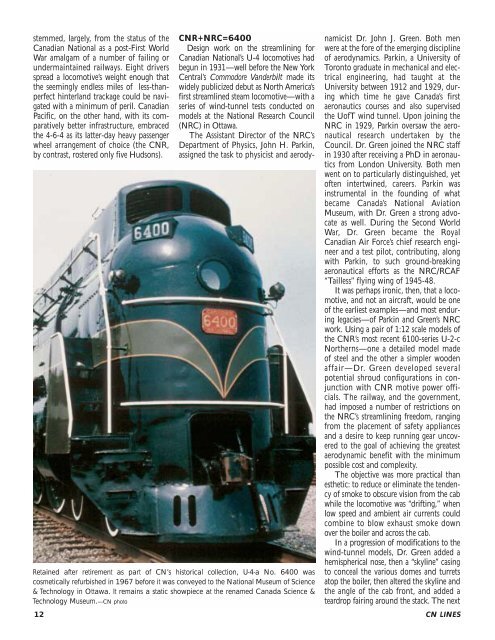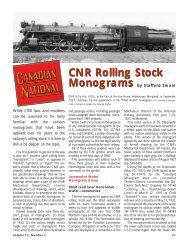CN LINES V12N3 - Canadian National Railways Historical Association
CN LINES V12N3 - Canadian National Railways Historical Association
CN LINES V12N3 - Canadian National Railways Historical Association
Create successful ePaper yourself
Turn your PDF publications into a flip-book with our unique Google optimized e-Paper software.
stemmed, largely, from the status of the<br />
<strong>Canadian</strong> <strong>National</strong> as a post-First World<br />
War amalgam of a number of failing or<br />
undermaintained railways. Eight drivers<br />
spread a locomotive’s weight enough that<br />
the seemingly endless miles of less-thanperfect<br />
hinterland trackage could be navigated<br />
with a minimum of peril. <strong>Canadian</strong><br />
Pacific, on the other hand, with its comparatively<br />
better infrastructure, embraced<br />
the 4-6-4 as its latter-day heavy passenger<br />
wheel arrangement of choice (the <strong>CN</strong>R,<br />
by contrast, rostered only five Hudsons).<br />
<strong>CN</strong>R+NRC=6400<br />
Design work on the streamlining for<br />
<strong>Canadian</strong> <strong>National</strong>’s U-4 locomotives had<br />
begun in 1931—well before the New York<br />
Central’s Commodore Vanderbilt made its<br />
widely publicized debut as North America’s<br />
first streamlined steam locomotive—with a<br />
series of wind-tunnel tests conducted on<br />
models at the <strong>National</strong> Research Council<br />
(NRC) in Ottawa.<br />
The Assistant Director of the NRC’s<br />
Department of Physics, John H. Parkin,<br />
assigned the task to physicist and aerody-<br />
Retained after retirement as part of <strong>CN</strong>’s historical collection, U-4-a No. 6400 was<br />
cosmetically refurbished in 1967 before it was conveyed to the <strong>National</strong> Museum of Science<br />
&Technology in Ottawa. It remains a static showpiece at the renamed Canada Science &<br />
Technology Museum.—<strong>CN</strong> photo<br />
namicist Dr. John J. Green. Both men<br />
were at the fore of the emerging discipline<br />
of aerodynamics. Parkin, a University of<br />
Toronto graduate in mechanical and electrical<br />
engineering, had taught at the<br />
University between 1912 and 1929, during<br />
which time he gave Canada’s first<br />
aeronautics courses and also supervised<br />
the UofT wind tunnel. Upon joining the<br />
NRC in 1929, Parkin oversaw the aeronautical<br />
research undertaken by the<br />
Council. Dr. Green joined the NRC staff<br />
in 1930 after receiving a PhD in aeronautics<br />
from London University. Both men<br />
went on to particularly distinguished, yet<br />
often intertwined, careers. Parkin was<br />
instrumental in the founding of what<br />
became Canada’s <strong>National</strong> Aviation<br />
Museum, with Dr. Green a strong advocate<br />
as well. During the Second World<br />
War, Dr. Green became the Royal<br />
<strong>Canadian</strong> Air Force’s chief research engineer<br />
and a test pilot, contributing, along<br />
with Parkin, to such ground-breaking<br />
aeronautical efforts as the NRC/RCAF<br />
“Tailless” flying wing of 1945-48.<br />
It was perhaps ironic, then, that a locomotive,<br />
and not an aircraft, would be one<br />
of the earliest examples—and most enduring<br />
legacies—of Parkin and Green’s NRC<br />
work. Using a pair of 1:12 scale models of<br />
the <strong>CN</strong>R’s most recent 6100-series U-2-c<br />
Northerns—one a detailed model made<br />
of steel and the other a simpler wooden<br />
affair—Dr. Green developed several<br />
potential shroud configurations in conjunction<br />
with <strong>CN</strong>R motive power officials.<br />
The railway, and the government,<br />
had imposed a number of restrictions on<br />
the NRC’s streamlining freedom, ranging<br />
from the placement of safety appliances<br />
and a desire to keep running gear uncovered<br />
to the goal of achieving the greatest<br />
aerodynamic benefit with the minimum<br />
possible cost and complexity.<br />
The objective was more practical than<br />
esthetic: to reduce or eliminate the tendency<br />
of smoke to obscure vision from the cab<br />
while the locomotive was “drifting,” when<br />
low speed and ambient air currents could<br />
combine to blow exhaust smoke down<br />
over the boiler and across the cab.<br />
In a progression of modifications to the<br />
wind-tunnel models, Dr. Green added a<br />
hemispherical nose, then a “skyline” casing<br />
to conceal the various domes and turrets<br />
atop the boiler, then altered the skyline and<br />
the angle of the cab front, and added a<br />
teardrop fairing around the stack. The next<br />
12 <strong>CN</strong> <strong>LINES</strong>



